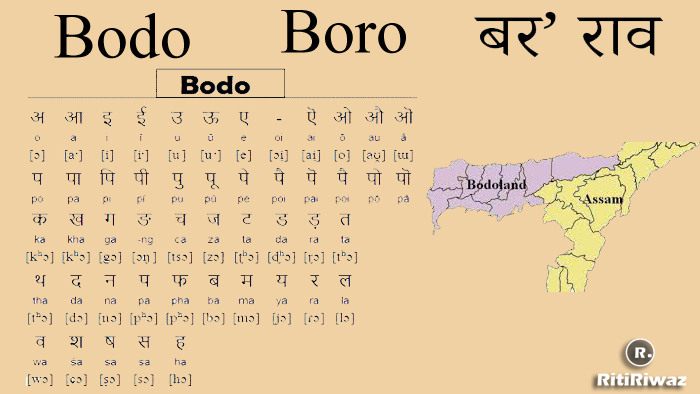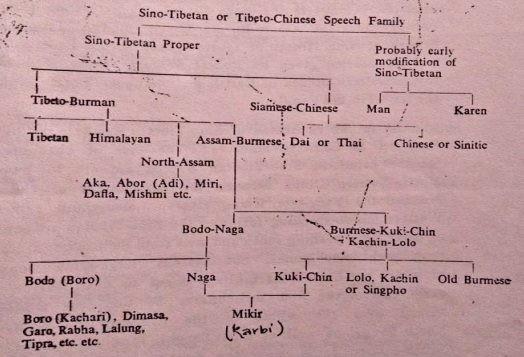Bodo Language | Boro

Bodo language (Pronunced as Bo-Ro) and also referred to as Mech, is a Sino-Tibetian language spoken primarily by the Bodo people of Northeast India, Nepal, and Bengal. It was known as Deodhai in the pre-13th century era and is the second-largest language in the North-Eastern region of India.
It is the official language of Bodoland and the co-official language of Assam and Meghalaya and is also spoken in Bangladesh. It is closely related to the Dimasa language (Assam), Garo language (Meghalaya), and the Kokborok language spoken in Tripura, it is one of the 22 recognized languages given a special constitutional status in India.
History of Bodo Language

Bodo is a Sino-Tibetan language of the Bodo group. Though Bodo is an ancient language but doesn’t have any written literature as it was only after the second decade of the 20th century some written text is found. Due to the Assamese language movement peaking in 1960, the Bodo community felt threatened and decided not to use the Assamese script. As a result of socio-political awakenings and various movements launched by different Bodo organizations from 1913, the Bodo language was introduced in 1963 as the medium of instruction at the primary level in an area dominated by Bodo-Kachari people who were the earliest settlers of Assam.
Bodos lived in the scattered areas throughout Assam, Meghalaya, Nagaland, Tripura, West Bengal, Arunachal Pradesh, Mizoram, Manipur, Bihar, and adjoining parts outside India. They were nature lovers and lived near river valleys, having their own culture, society, and language. According to Madhu Ram Baro, “Boro is the offshoot language of Tibeto-Burman sub-family of the Tibeto-Chinese main family itself.”
While Bodo is officially written in the Devanagri script, the language has a history of having been written in at least three different scripts – until, in 1974, the Government recognized Devanagari as its official script. In the first decade of the 20th century, Bodos started writing in the Assamese/Bangla script. Then they also used Roman Script for writing the language.
In 1996 the language was used at the University of Guwahati and it now has a number of books and literature. The spoken Bodo language has been affected by various dialects but you can still hear the pure form in Udalguri district. Now the 2020 Accord makes Bodo the associate official language throughout Assam. “Today Centre, Assam government and Bodo representatives have signed an important agreement. This agreement will ensure a golden future for Assam and for the Bodo people. 1550 cadres along with 130 weapons will surrender on January 30. As the Home Minister, I want to assure all representatives that all promises will be fulfilled in a time-bound manner” said the home minister.
Dialects
The dialects spoken in this area can be divided into three main groups:
- The Western Boro dialect, spoken in Kokrajhar and Bongaigaon districts and gained the standard dialect.
- The Eastern Boro dialect is spoken in Barpeta, Nalbari, and Kamrup districts and some parts of Darrang.
- The Southern Boro dialect is spoken in the South bank of Brahmaputra, Chayagaon, Rani Area, and in some parts of Meghalaya State.
Salient Features of Bodo Language
1. Phonemic inventory of Bodo language consists of six vocalic phonemes i.e. /, u, e, o, a /, eight diphthongs i.e. / iu, шi, шu, ui, eu, oi, ai, and au/. All the vocalic Phonemes of the Bodo language are voiced and short vowels. Long occurs by this language.
2. Using of / ш / high back un-rounded vowel is one of the most special features of the Bodo language. It occurs in all the positions of a word. Juncture, Tone, and Intonation are the Supra-segmental features found in this language.
3. There are sixteen consonant phonemes in the Bodo language i.e. / ph , b, th , d, kh , g, m, n, ŋ, s, z, h, r, l, w, y /, where /w/ and /y/ are Semi vowels of Segmental features. Besides this, some other phonemes are also used in various loan words.
4. Consonant clusters in Bodo has occurred only in the initial and middle positions of a word.
5. In Bodo, the Gemination sequence occurs in two consonant sequences only which is merely used in the middle position of a word, and the non-gemination sequence occurs in two consonant sequences as well as three consonant sequences. These occur only in the middle position of a word.
6. The syllabic classification of Bodo language is of three types i.e. monosyllabic, di-syllabic, or bi-syllabic and poly-syllabic and from the structural form of a syllable, it is of two types open syllable and closed syllable.
7. Two types of juncture i.e. Close juncture and Open juncture are commonly occurs in the Bodo language.
8. In Bodo two tones are occurring high tone and low tone.
9. In intonation patterns three types of intonations are occurring i.e. High falling, Low rising, and Level.
10. Based on the manner of articulation there is a minimum of two different types of allophones in each vowel and consonant phonemes in the Bodo language.






